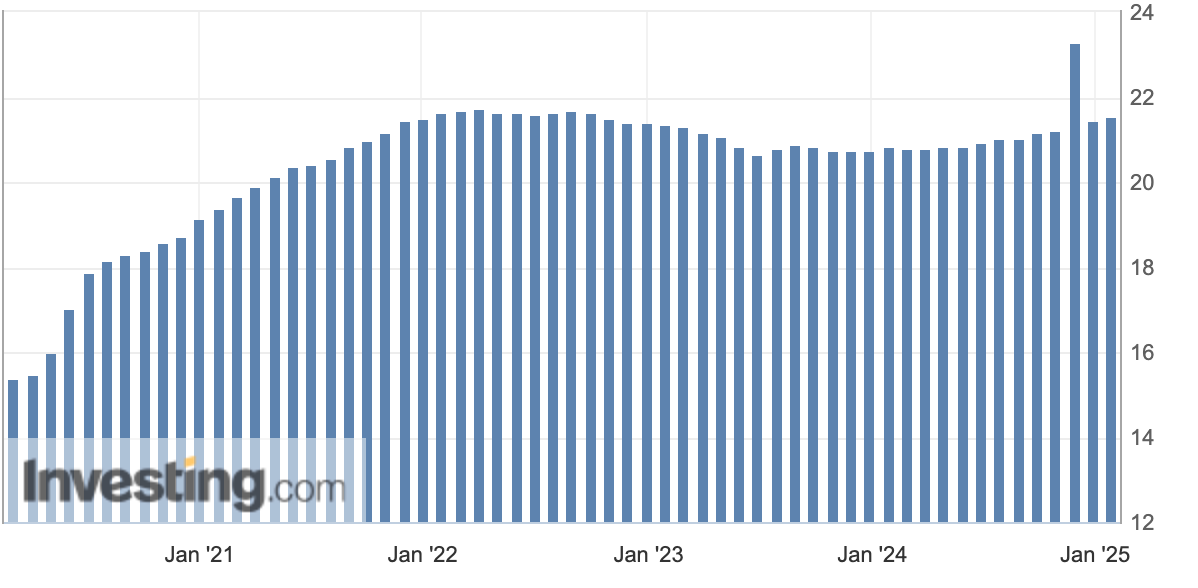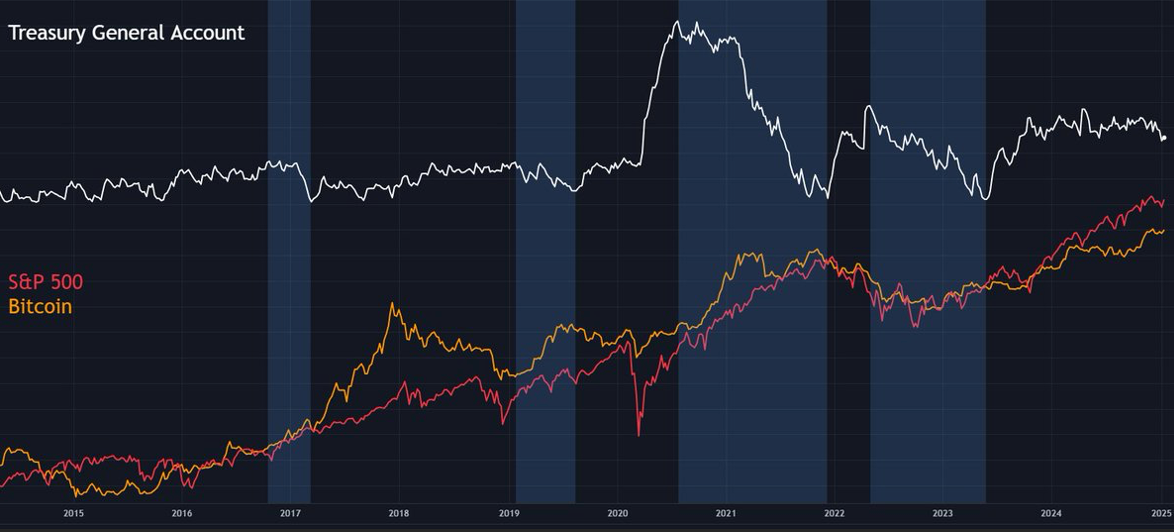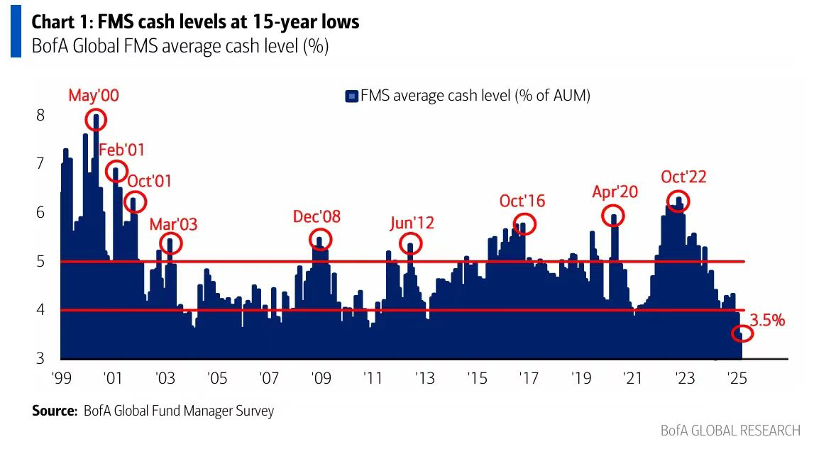Written by: OKG Research
In 2025, the "America First" strategy implemented by Trump aims to stimulate domestic economic growth through trade protectionism, promoting industrial return, tax reform, and increased military spending. The focus is on strengthening the independence of American manufacturing, technology, and energy sectors while enhancing export competitiveness. The core objective of this series of policies is to drive the recovery of the American economy while reducing dependence on foreign production and capital, thereby enhancing America's dominant position in the global economy.
As these policies continue to advance, the significant fiscal spending and deficit issues triggered by increased military expenditure and large-scale infrastructure construction cannot be overlooked. Coupled with the existing pressures on U.S. debt and potential inflation expectations, investors may begin to explore different risk-hedging assets. Cryptocurrency assets have become a pivot in the "Trump economics" framework.
Despite the continuous inflow of institutional funds, the current investor expectations have become the main variable determining market direction, and actual funds do not bring much dopamine to the market. This article is the fourth piece in OKG Research's special series on Trump economics in 2025, exploring the current dilemmas in the cryptocurrency market and the market impact of large-scale liquidity releases in 2025.
The Cryptocurrency Market's Struggle for Liquidity
Under the push of Trump economics, the U.S. self-sufficiency and industrial revival policies face high inflation and high debt pressures. Although the U.S. macro CPI/PPI data from February 12 to 13 did not trigger significant market fluctuations, it is because these data are still superficial indirect data rather than direct data. For institutional funds, the market is more about digesting previous expectations. The real market benefits appeared in early February during the liquidity release from the Treasury, which injected substantial momentum into the market and drove up risk assets.
Specifically, the inflow of institutional investors resembles the realization of expectations and the redistribution of existing market funds based on this. In a macro report released by OKG Research last weekend, the author pointed out that for the market, "limited liquidity" and "precise reallocation" are currently concentrated on Bitcoin, due to the change in trading behavior of the main holders behind it. Institutional investors tend to hold long-term and concentrated positions, so ETF flows rarely spill over into other assets, which is one of the main reasons why investors are eagerly awaiting the "altcoin season."
However, despite the Federal Reserve's meeting minutes on February 19 emphasizing a cautious stance on interest rate cuts, this did not significantly impact U.S. stocks. Observing the market, the expectation of not cutting rates seems to have been digested, or the market has begun to preemptively trade on expectations of "pausing or slowing down balance sheet reduction."
It cannot be denied that regardless of how expectations change, they are based on macroeconomic conditions; expectations do not equate to a "gamble" on the macro. As of now, what we observe is that the Federal Reserve's monetary policy will still face two major pressures: high inflation and high debt levels will make the Fed's monetary policy more cautious. This means that even in the face of slowing economic growth, the Fed may avoid overly loose monetary policies.
A New Round of "Liquidity Manifestation" in the Cryptocurrency Market May Have Arrived
Although it appears that the U.S. will not implement large-scale quantitative easing (QE) in 2025 as it did in 2018 and 2020, injecting market liquidity through the purchase of government bonds and debt assets to stimulate economic growth, the Treasury General Account (TGA) has begun injecting liquidity into the market this week to address the debt ceiling issue.
Historically, whenever the U.S. government faces a debt ceiling issue, the market often experiences short-term liquidity releases (from the TGA), which in turn drives up the prices of various assets, especially risk assets. The TGA is an important tool for the government to manage daily cash flow. The balance of this account is adjusted based on the government's revenue and expenditure situation. When facing debt ceiling restrictions, the Treasury usually reduces the supply of government bonds and instead uses funds from the TGA account to maintain normal government operations.
In fact, changes in the TGA balance directly affect the liquidity of financial markets. Each time there is a large-scale liquidity release, risk assets, especially cryptocurrency assets, tend to respond with price increases. For instance, from mid-2020 to the end of 2021 (during which monetary policy was also a factor), Bitcoin increased approximately sixfold. During this period, the growth of U.S. M2 also reached over 40%, marking the fastest growth phase in five years.

During the period from the first half of 2022 to the first half of 2023, Bitcoin's price showed a certain lag during the TGA liquidity release phase. In this phase, Bitcoin's price increased by about 100% from its lowest to highest point; however, from the start of liquidity release to the end of the phase, the overall increase in Bitcoin's price was about 10%.

According to Goldman Sachs' latest report, the first round of short-term TGA liquidity injection in 2025 is expected to be around $150 billion to $250 billion. This is expected to continue until summer when a new agreement is reached. This is the first foreseeable liquidity release. Other institutions have also analyzed that the first round is expected to inject a total of about $600 billion in liquidity.
According to Bank of America's latest macro analysis report, the cash holdings of global fund managers fell to a low of 3.5% in February 2025, reflecting an increase in investors' risk appetite—they prefer stocks over cash and bonds. This rise in risk appetite coincides perfectly with the timing of the current TGA liquidity release. In other words, this round of short-term liquidity injection is expected to flow largely into the risk asset market, including cryptocurrency assets. The direction of fund flows and the preference for risk assets may further drive up the cryptocurrency market.

Not QE, but Better Than QE?
Within the framework of Trump economics, the strategy of promoting America First relies not only on trade protectionism and industrial return but also on strong support from fiscal and monetary policies. To achieve self-sufficiency and stimulate the domestic economy, the Trump administration prefers to utilize fiscal tools, such as the TGA (Treasury General Account), and inject liquidity through monetary policy tools when necessary to drive economic growth.
Unlike quantitative easing (QE), which is a long-term monetary policy tool, TGA liquidity releases are one-time, short-term operations. By reducing the issuance of government bonds and using funds from the TGA account to meet short-term liquidity needs, the government can quickly inject liquidity into the market. Although this injection can drive up risk assets in the short term, the temporary nature of TGA funds means that liquidity may be quickly withdrawn in later stages, potentially leading to a tightening effect on market liquidity.
In contrast, QE is a means by which the Federal Reserve expands its balance sheet over the long term by purchasing assets (such as government bonds) and continuously injecting funds into the market to stabilize financial markets and stimulate economic growth. The long-term and sustained nature of QE sharply contrasts with the short-term nature of TGA. To achieve the goals of industrial revival and enhanced competitiveness, the Trump administration needs to utilize TGA for short-term liquidity injections while relying on loose monetary policies for long-term support of the economy. However, the short-term liquidity release from TGA may conflict with the Fed's direction of monetary tightening, potentially leading to market uncertainty and affecting the overall execution of economic policies.
In summary, the Trump administration's short-term liquidity release through TGA has injected new vitality into the market. Although this release is not a long-term monetary easing policy like QE, it is sufficient to drive up risk assets such as cryptocurrency in the short term. For the cryptocurrency market, the short-term inflow of funds is undoubtedly a rare opportunity, but the accompanying tightening effect on liquidity and the U.S. debt issue still require attention. Long-term economic stability still relies on the effective coordination of fiscal and monetary policies within the framework of Trump economics. In the coming months, the monetary and fiscal policy tools adopted based on this framework will largely determine the performance of the cryptocurrency market.
免责声明:本文章仅代表作者个人观点,不代表本平台的立场和观点。本文章仅供信息分享,不构成对任何人的任何投资建议。用户与作者之间的任何争议,与本平台无关。如网页中刊载的文章或图片涉及侵权,请提供相关的权利证明和身份证明发送邮件到support@aicoin.com,本平台相关工作人员将会进行核查。




